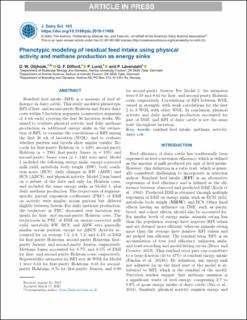| dc.description.abstract | Residual feed intake (RFI) is a measure of feed efficiency in dairy cattle. This study modeled phenotypic RFI of first- and second-parity Holstein and Jersey dairy cows within 9 lactation segments (consecutive segments of 4 wk each) covering the first 36 lactation weeks. We aimed to evaluate physical activity and daily methane production as additional energy sinks in the estimation of RFI, to examine the correlations of RFI among the first 36 wk of lactation (WOL), and to evaluate whether parities and breeds show similar results. Records for first-parity Holstein (n = 449), second-parity Holstein (n = 298), first-parity Jersey (n = 195), and second-parity Jersey cows (n = 146) were used. Model 1 included the following energy sinks: energy-corrected milk yield, metabolic body weight (BW), body condition score (BCS), daily changes in BW (ΔBW) and BCS (ΔBCS), and physical activity. Model 2 was based on a subset of the data and only for Holstein cows, and included the same energy sinks as Model 1, plus daily methane production. The trajectories of segment-specific partial regression coefficients (PRC) of DMI on activity were similar across parities but differed slightly between breeds. For daily methane production, the trajectory in PRC decreased over lactation segments for first- and second-parity Holstein cows. The trajectories in PRC of DMI on energy-corrected milk yield, metabolic BW, BCS, and ΔBW were generally similar across parities, except for ΔBCS. Activity accounted for on average 7.3, 6.8, 7.2, and 6.4% of DMI for first-parity Holsteins, second-parity Holsteins, first-parity Jerseys, and second-parity Jerseys, respectively. Methane losses accounted for 8.7% and 8.5% of DMI for first- and second-parity Holstein cows, respectively. Repeatability estimates for RFI over 36 WOL for Model 1 were 0.63 for first-parity Holsteins, 0.65 for second-parity Holsteins, 0.76 for first-parity Jerseys, and 0.80 for second-parity Jerseys. For Model 2, the estimates were 0.59 and 0.61 for first- and second-parity Holstein cows, respectively. Correlations of RFI between WOL varied in strength, with weak correlations for the first 2 to 3 WOL with other WOL. In conclusion, physical activity and daily methane production accounted for part of DMI, and RFI of dairy cattle is not the same trait throughout lactation. | |
